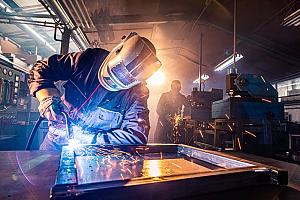- FMA
- The Fabricator
- FABTECH
- Canadian Metalworking
Our Publications
Categories
- Additive Manufacturing
- Aluminum Welding
- Arc Welding
- Assembly and Joining
- Automation and Robotics
- Bending and Forming
- Consumables
- Cutting and Weld Prep
- Electric Vehicles
- En Español
- Finishing
- Hydroforming
- Laser Cutting
- Laser Welding
- Machining
- Manufacturing Software
- Materials Handling
- Metals/Materials
- Oxyfuel Cutting
- Plasma Cutting
- Power Tools
- Punching and Other Holemaking
- Roll Forming
- Safety
- Sawing
- Shearing
- Shop Management
- Testing and Measuring
- Tube and Pipe Fabrication
- Tube and Pipe Production
- Waterjet Cutting
Industry Directory
Webcasts
Podcasts
FAB 40
Advertise
Subscribe
Account Login
Search
The 10 most read Additive Report posts of 2020
Content about 3D printing software, hardware, and shops were the most visited posts the past 12 months
- December 30, 2020
- Article
- Additive Manufacturing
Visitors to The Additive Report website last year gravitated to articles about additive manufacturing software, 3D printers, and additive shops that focus on a certain type of 3D printing. (See the 10 most viewed reports below.)
Postprocessing continued to be of major interest to viewers, too, and, for the first time, one of our videos was among the most viewed content of the year.
Thanks for visiting the AR website in 2020. We look forward to bringing you the latest news on the additive manufacturing industry in 2021.
1. A richer 3D printing file format grows in popularity
The stereolithography (STL) format is the oldest and most popular format for 3D printing files. But an influential consortium believes there is a better alternative to STL—the 3D Manufacturing Format (3MF).
2. Postprocessing separates additive manufacturing from 3D printing
What sets additive manufacturing apart from 3D printing is all the processes performed besides printing. Expertise in postprocessing is critical to meeting customers’ expectations for high-quality 3D-printed parts.
3. 3D printing drives NASCAR champ’s factory
NASCAR champion Brad Keselowski owns and operates a 70,000-sq.-ft. plant committed to using subtractive and additive manufacturing in a hybrid strategy to produce high-end parts. As a race car driver, he said, “I look at the technology and think, ‘I’m in a position to push it forward into real applications that can change the world.’”
4. Metal 3D printer eliminates the debinding step
Rapidia Tech Inc.’s dual-head, metal 3D printer lays down a paste of metal powder, water, and just 0.3% to 0.4% of a polymer binder. The process reportedly eliminates the often days-long debinding process needed with competitive technologies, allowing parts to go from printer to sintering oven.
5. 3D printing shop takes ‘innovative’ approach to serving customers
Carl Douglass, the president and co-owner of DI (Douglass Innovations) Labs, said he and his brothers, Brian and Sean, have only one regret: That they didn’t get into 3D printing sooner. He added, “It takes time to get your head wrapped around the full capabilities of 3D printing, even for the most innovative of mindsets … it takes a paradigm shift.”
6. Generative design software: a different approach to designing
User-friendlier generative design software is a “good match” for additive manufacturing. The software can be used, for example, to produce parts that experience lower stresses during use. This allows parts to be made with less material, which, in turn, lowers material costs.
7. New design/print/go additive manufacturing system speeds parts-building
Arevo’s additive manufacturing system combines a patented software algorithm, carbon-fiber materials, and robotic 3D printing technology to make large parts such as airplane wings. According to the cofounder and chairman of the company, Hemant Bheda, the system “eliminates the hand labor and oven-curing steps, and with our software and fully automated robotic 3D printer enclosure, we can realize these products almost instantaneously.”
8. Filling the gap between plastic and metal 3D printing
Electroplating 3D-printed plastic parts is a cost-effective alternative to printing with metal, say Formlabs and electroplating specialist RePliForm. The CEO of the electroplater, Sean Wise, said four 3D-printed plastic parts plated with 50 microns of copper and nickel would cost $456 versus $1,600 for four 3D-printed stainless steel parts.
9. 3D printing: outsource or DIY?
In a special video report, Additive Report Editor Don Nelson asks experts to explain when manufacturers interested in 3D printing should buy a printer and perform the work in-house and when they should outsource the task.
10. Wire-arc additive manufacturing can be used to build very large parts to near-net shape
Wire-arc additive manufacturing is a method of 3D-printing large metal parts by combining robotics and arc welding. The only limitation on the size of WAAM-built components is the size of the equipment used. And, WAAM’s ability to produce near-net-shape parts without tooling, molds, or furnaces reduces production time.
About the Publication
- Podcasting
- Podcast:
- The Fabricator Podcast
- Published:
- 07/02/2024
- Running Time:
- 66:34
Desirée Guzmán, a welding instructor with Chicago Women in Trades (CWIT), joins us to talk about her full-circle...
- Trending Articles
- Industry Events
Precision Press Brake Certificate Course
- July 31 - August 1, 2024
- Elgin,
Laser Welding Certificate Course
- August 6 - 8, 2024
- Farmington Hills, IL
Golf 4 Manufacturing
- August 19, 2024
- Waukegan,
The Fabricator's Technology Summit
- August 20 - 21, 2024
- Eglin, IL



























